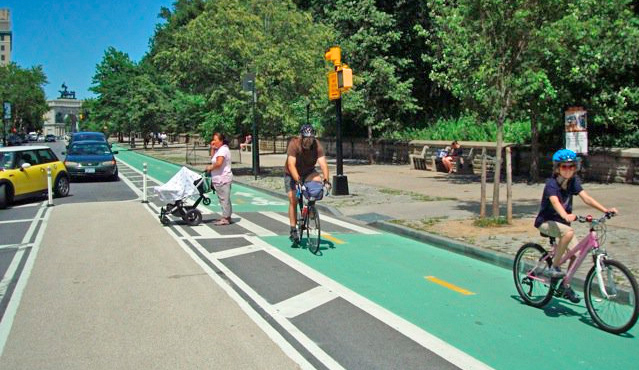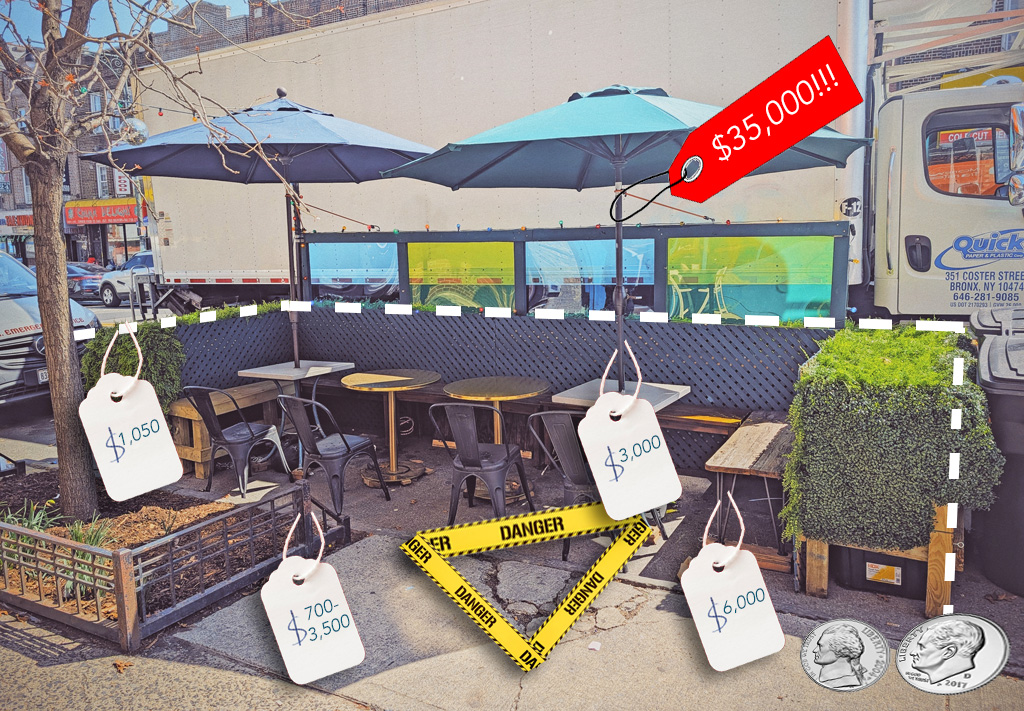The de Blasio administration must make an ambitious, and wholehearted, break from the past and remove the NYPD from its disproportionately large oversight of traffic enforcement in the city, to make our streets safer from crashes, but also protect people of color from the cops themselves, a new report argues.
The new report, "The Case for Self-Enforcing Streets" from Transportation Alternatives [PDF], offers a slate of recommendations — some new and some older ideas that have resurfaced, thanks to the current debate over the future of policing, specifically in public space, where "armed policing" causes "harm."
“It has become abundantly clear that the NYPD’s approach to traffic safety is not working, especially for New Yorkers of color,” said Transportation Alternatives Deputy Director Marco Conner DiAquoi. “We know what works, and that’s street design that is always on duty, and automated enforcement technology that doesn’t discriminate. This is an inflection point, and our elected leaders have a choice: will New York become a leader in progressive, racially-just traffic safety, or will we continue with the police-dominant status quo?”
Overall, the best thing about getting police out of the role of enforcement in favor of good roadway design is that design is on the job 24-7, and without the built-in bias that many police officers carry with them, said Joe Cutrufo of Transportation Alternatives.
"We know that police officers can't possibly issue as many speeding tickets as cameras can, and the cameras do not come with the problems associated with having armed police officers pulling over people," he said. Also, he pointed out, the cities on statistic show that people who receive one speed camera ticket are extremely unlikely to get another, suggesting that drivers do change their behavior based on the cameras.
In addition to expand the design mandates, the report recommends:
- Expanding automated enforcement technology to include parking, bus lanes, bike lanes, failure to yield, and protection at crosswalks: Much of this technology exists already, but advances in cameras and software will someday enable cameras to detect when drivers have cut off a pedestrian at a crosswalk, Cutrufo said.
- Changing the way the NYPD does crash investigations: Currently, the NYPD’s Collision Investigation Squad investigates almost all fatal crashes, but left that leaves tens of thousands of crashes completely uninvestigated. In addition, the Department of Health and Mental Hygiene and the Department of Transportation aren't really involved in the investigations. "If a crash investigation excludes the DOT, what have we learned from the crash?" Cutrufo said, rhetorically.
- Expanding transparency in reporting street and sidewalk enforcement: This has long been an issue with anyone who has tried to document how well or poorly the NYPD does its enforcement. The agencies commitment to public information release is, to say the least, sketchy at best.
- Rolling back the 2019 expansion of transit police, along with the creation of a new multi-agency unit of social workers to assist unhoused people on public transit.
- Ending the crackdown against working cyclists: this has long been a part of the Transportation Alternatives agenda, but with the state having legalized e-bikes with legislation in Albany, it now falls to the de Blasio administration to come up with suitable regulations, which it had stalled, mostly because of the coronavirus outbreak. Nonetheless, even though delivery cyclists were deemed essential workers, and the mayor announced that the NYPD would not crack down on them during the pandemic, there were repeated reports of delivery workers, indeed, being hassled and arrested during the crisis.
- Adopting equitable deterrence mechanisms: The report recommends sliding scale fines and the option to fix equipment violations in exchange for waived fines.
Along with the report, Transportation Alternatives has launched a petition calling for the reallocation of a portion of the NYPD budget to the DOT.
The report was obviously in the works for months, but the timing is especially apt, as pressure builds on Mayor de Blasio to get police out of many of their current responsibilities because of their statistically documented inability to be completely impartial where race is concerned. As Streetsblog has reported, the NYPD has tentacles into many agencies, and has a far larger workforce per capita than other cities in America.
In addition, the City Council is moving towards reducing the NYPD's bloated $6-billion budget by a full $1 billion. Also, the NYPD has long been a very poor Vision Zero partner of the department of transportation, as Streetsblog recently documented.
So not only is "police officer-based enforcement is less effective than infrastructural alternatives, like street redesigns and automated enforcement," but it also "puts people of color at risk" because of the higher chance that a police interaction with a person of color will lead to violence then the same encounter a white person.
As the report says, "Nationwide, black drivers are almost twice as likely to be pulled over as white drivers. New Yorkers, especially immigrants, people of color, and the unhoused, have seen disastrous consequences from the policing of streets and sidewalks, from onerous fines to incarceration to death. ... Under the de Blasio administration, Black and Latinx men aged 14-24, who make up less than 5 percent of the population, made up nearly 40 percent of those stopped by police on the sidewalk."
The report also cited Streetsblog's coverage this year revealing that more than 90 percent of cop-issued jaywalking tickets go to black or Hispanic people.
Of course, the larger problem is the basic ineffectiveness of the police.
In 2017, there were 46,000 hit-and-run crashes in New York City — yet cops only caught 1 percent of those reckless drivers — and hit-and-run crashes are on the rise increasing 26 percent of the last five years, the report says.

At the same time, city infrastructure projects designed to reduce these traffic crashes "have proven effective and scalable." Protected bike lanes, for example, not only reduce crashes, but also reduce the supposed need for police involvement, due to as much as a 94-percent drop in cycling on the sidewalk, which has long been a way for Police to target black and Latino youths.
Automated speed cameras have reduced the number of people killed or seriously injured by as much as 50 percent, and reduced speeding by over 60 percent, the report adds.
And the best thing about speed cameras, is that a scofflaw driver cannot talk his or her way out of a ticket by flashing a PBA courtesy card or by saying he or she is "on the job."
The report will likely be cheered by supporters of police reform, many of whom provided support for the Transportation Alternatives press release.
"Ending traffic enforcement is another step to ending racist policing and making our communities safer," said Council Member Carlos Menchaca. "Traffic enforcement is part of the muddle that thinks punishment will create deterrence, when in reality it perpetuates the very systems of oppression that the pandemic and recent police brutality laid bare. As we move to defund the NYPD and refund our communities, we must also end this retributive traffic model."
It is unclear if any of the recommendations will lead to the return of traffic enforcement agents to the purview of the DOT. After Transportation Alternatives Executive Director Danny Harris and Mark Winston Griffith of the Brooklyn Movement Center penned an op-ed in Gotham Gazette last week titled, "Remove the NYPD from the Enforcement of Streets and Sidewalks," the union representing traffic enforcement agents was displeased, and made that displeasure known with its own op-ed in the same outlet today.
Until 1996, traffic enforcement agents worked for the Department of Transportation. Their union, and rank-and-file, believe that the blue NYPD uniform reduces the number of attack on these agents. But because traffic enforcement agents are under the NYPD's oversight, many believe they are less likely to issue tickets to the police brothers and sisters under the current arrangement.
Oddly, even though they work under the auspices of the NYPD, traffic enforcement agents are technically considered civilians, not peace officers. The de Blasio administration opposes state legislation to give them the status of cops.
In comments to reporters this morning, Mayor de Blasio obliquely addressed the question at hand, but was not asked directly about the Transportation Alternatives report. The mayor said:
Some people are proposing taking some units out of the NYPD, putting them in another agency, funding them exactly the same way, having them do exact same work. That may have merit, but I don't want it to be misconstrued. There are some things I think can be done better by civilians than by NYPD, and some things done better by NYPD than civilians. We've got to work out which is which, but that doesn't implicitly mean a budget savings.
Some are just calling for a pure budget reduction to the NYPD. So when you say something like traffic enforcement or anti-crime, that work has to happen, it's going to happen with the same people in different ways potentially, but it has to happen. So I don't want there to be a misunderstanding about that. I think the anti-crime point is, are there some things that the same people might do it, the same mission has to be done, but they might do it a different way. Yeah, we have to look at all of that.






